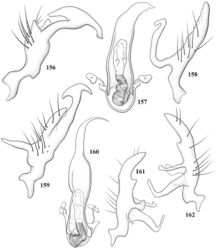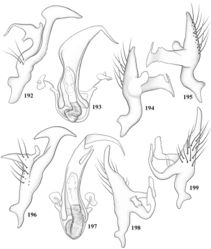Ceratocapsidea
| Notice: | This page is derived from the original publication listed below, whose author(s) should always be credited. Further contributors may edit and improve the content of this page and, consequently, need to be credited as well (see page history). Any assessment of factual correctness requires a careful review of the original article as well as of subsequent contributions.
If you are uncertain whether your planned contribution is correct or not, we suggest that you use the associated discussion page instead of editing the page directly. This page should be cited as follows (rationale):
Citation formats to copy and paste
BibTeX: @article{Henry2015ZooKeys, RIS/ Endnote: TY - JOUR Wikipedia/ Citizendium: <ref name="Henry2015ZooKeys">{{Citation See also the citation download page at the journal. |
Ordo: Hemiptera
Familia: Miridae
Name
Ceratocapsidea Henry gen. n. – Wikispecies link – ZooBank link – Pensoft Profile
Type species:
Ceratocapsus balli Knight, 1927.
Diagnosis
This genus is distinguished by a combination of an often shiny dorsum, usually polished head and pronotum; the generally thickened antennal segments I–III, especially in males; the weakly rounded, subparallel to weakly constricted hemelytra with distinct, uniformly distributed, usually brown-stained punctures, often with erect, slender to stout bristle-like setae, intermixed with slender, pale or silvery scale-like setae, especially on the clavus and basal half of the corium; the distinctive stridulatory patch ventrally on abdominal segments II and III; and the distinctive male genitalia, with the main body of the right paramere stout with one or more variously shaped lateral arms, the left paramere usually with one or two dorsal spines or variously shaped processes and the left-most process usually forming a hammer- or beak-like process; and the phallotheca usually apically acute, bifid, or hooked.
Description
Males and females macropterous. Length of males 2.82–3.71 mm; length of females 2.27–3.58 mm. Head: Broader than long; posterior margin truncate to slightly concave, narrowly carinate, posterior margin of eyes level with base of vertex; eye large, broadly rounded, coarsely faceted, dorsal width of one eye greater than interocular width, lateral height in males equal or subequal (0.90) to height of head, from about one half to slightly less than three fourths (0.70) height in females; frons broad, shiny to dull, smooth to transversely rugose; clypeus moderately acute, visible from dorsal aspect; scattered with semierect and erect, simple setae. Labium: Segment I long, extending posteriorly well beyond base of head, with only basal half enclosed within buccula; segment IV extending to middle or hind coxae. Antenna: Slender to weakly thickened, especially in males; segment I shortest; segment II longest, slender basally, gradually enlarging to apex, sometimes weakly clavate; segment III slightly longer than IV, both subequal to apical diameter of segment II. Pronotum: Trapeziform, lateral margins straight to weakly sulcate, posterior margin weakly rounded; dorsum dull to shiny, finely to coarsely punctate, sometimes alutaceous to weakly rugose; calli indistinct; set with scattered erect and semierect, simple setae, often intermixed with short, silvery, sericeous setae. Mesoscutum: Covered by posterior margin of pronotum. Scutellum: Equilateral; evenly punctate, mixed with simple and silvery sericeous setae. Hemelytra: Weakly rounded to subparallel, sometimes weakly constricted through middle, especially in males; distinctly punctate, shiny to more dull; thickly set with short recumbent simple and silvery sericeous setae, often intermixed with long, erect, sometimes nearly bristle-like setae; all known species fully macropterous. Ventral surface: Shiny; clothed with short, recumbent, simple setae; base of abdominal segment III (second visible segment) in most species with a distinct stridulatory patch (Fig. 112) composed of tiny spicules or microspines. Ostiolar evaporative area: Pale, knob at end of scent channel relatively small, sometimes more reddish. Legs: Slender, unmodified. Male genitalia: Aperture large, open, unarmed; stridulatory patch ventrally on abdominal segments II and/or III distinct in most species; generalized left paramere usually with a large hammer- or beak-like process distally and one or two more basal short acute processes; right paramere with a main trunk and one to three variously shaped lateral arms; phallotheca slender with apex broadly pointed or ending in a slender acute or bifid process; endosoma simple, unmodified.
Etymology
The name of this new genus is taken from the generic name Ceratocapsus Reuter and Latin suffix “idea”, meaning form or appearance, and is used to reflect the overall resemblance of the two genera. The gender is feminine.
Discussion
Some members of this genus group are the least myrmecomorphic of the genera included in the Renodaeus group (e.g., Ceratocapsidea complicata, Ceratocapsidea rufistigma, Ceratocapsidea texensis). Nevertheless, the male genitalia hold these less-ant-like species together as a group close to the other seven genera treated in this paper.
The following key includes external morphology when possible to help distinguish species, though male genitalia are necessary to identity very similar species.
Key to the species of Ceratocapsidea
Original Description
- Henry, T; 2015: Revision of the Ceratocapsine Renodaeus group: Marinonicoris, Pilophoropsis, Renodaeus, and Zanchisme, with descriptions of four new genera (Heteroptera, Miridae, Orthotylinae) ZooKeys, (490): 1-156. doi
Images
|










